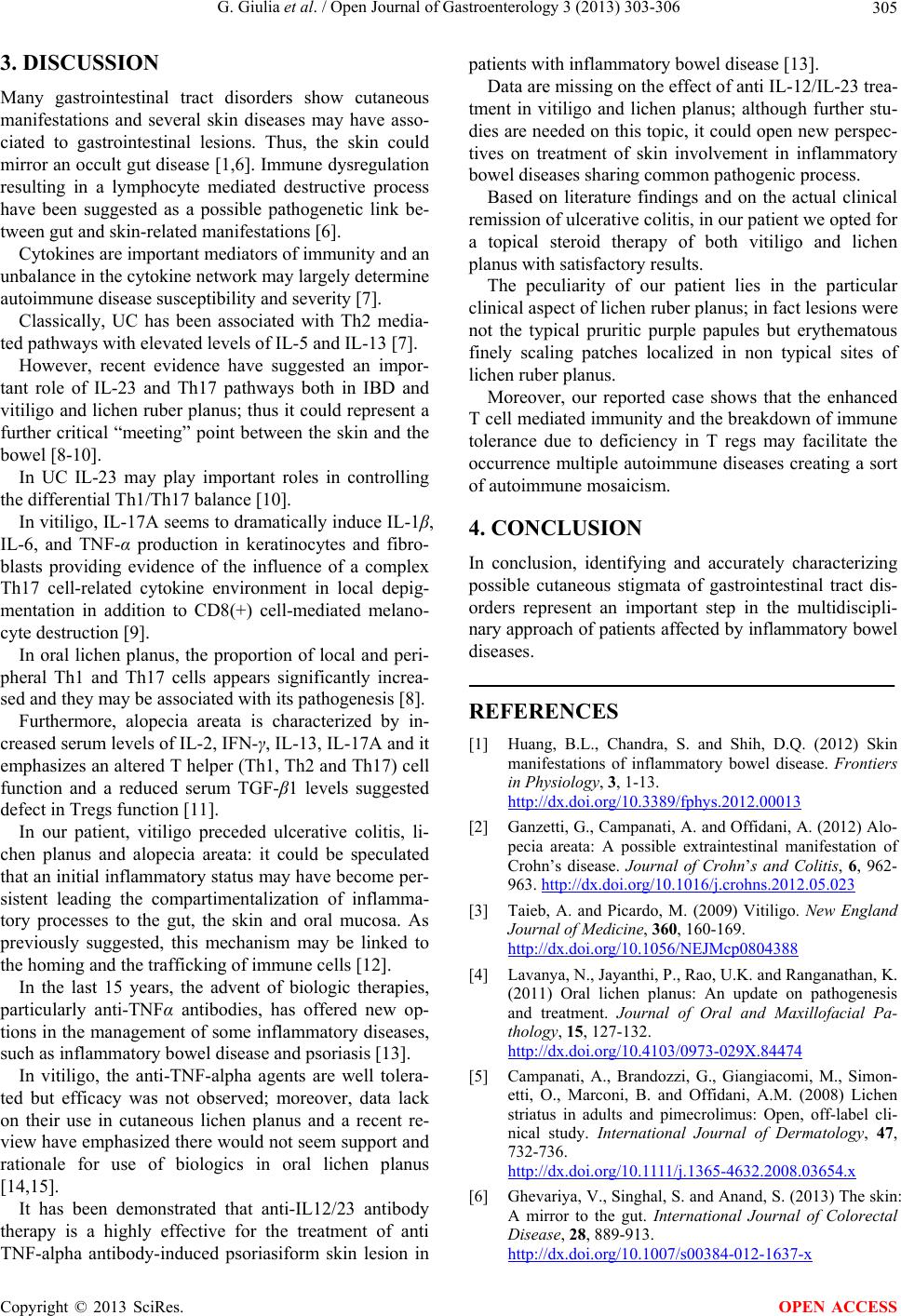
G. Giulia et al. / Open Journal of Gastroenterology 3 (2013) 303-306 305
3. DISCUSSION
Many gastrointestinal tract disorders show cutaneous
manifestations and several skin diseases may have asso-
ciated to gastrointestinal lesions. Thus, the skin could
mirror an occult gut disease [1,6]. Immune dysregulation
resulting in a lymphocyte mediated destructive process
have been suggested as a possible pathogenetic link be-
tween gut and skin-related manifestations [6].
Cytokines are important mediators of immunity and an
unbalance in the cytokine network may largely determine
autoimmune disease susceptibility and severity [7].
Classically, UC has been associated with Th2 media-
ted pathways with elevated levels of IL-5 and IL-13 [7].
However, recent evidence have suggested an impor-
tant role of IL-23 and Th17 pathways both in IBD and
vitiligo and lich en ruber planus; thus it could represent a
further critical “meeting” point between the skin and the
bowel [8-10] .
In UC IL-23 may play important roles in controlling
the differential Th1/Th17 balance [10].
In vitiligo, IL-17A seems to dramatically induce IL-1β,
IL-6, and TNF-α production in keratinocytes and fibro-
blasts providing evidence of the influence of a complex
Th17 cell-related cytokine environment in local depig-
mentation in addition to CD8(+) cell-mediated melano-
cyte destruction [9].
In oral lichen planus, the proportion of local and peri-
pheral Th1 and Th17 cells appears significantly increa-
sed and they may be associated with its pathogenesis [8].
Furthermore, alopecia areata is characterized by in-
creased serum levels of IL-2, IFN-γ, IL-13, IL-17A and it
emphasizes an altered T helper (Th1, Th2 and Th17) cell
function and a reduced serum TGF-β1 levels suggested
defect in Tregs function [11].
In our patient, vitiligo preceded ulcerative colitis, li-
chen planus and alopecia areata: it could be speculated
that an initial inflammatory statu s may have become per-
sistent leading the compartimentalization of inflamma-
tory processes to the gut, the skin and oral mucosa. As
previously suggested, this mechanism may be linked to
the homing and the trafficking of immune cells [12].
In the last 15 years, the advent of biologic therapies,
particularly anti-TNFα antibodies, has offered new op-
tions in the management of some inflammatory diseases,
such as inflammatory bowel disease and psoriasis [13].
In vitiligo, the anti-TNF-alpha agents are well tolera-
ted but efficacy was not observed; moreover, data lack
on their use in cutaneous lichen planus and a recent re-
view have emphasized there would not seem support and
rationale for use of biologics in oral lichen planus
[14,15].
It has been demonstrated that anti-IL12/23 antibody
therapy is a highly effective for the treatment of anti
TNF-alpha antibody-induced psoriasiform skin lesion in
patients with inflammatory bowel disease [13].
Data are missing on the effect of anti IL-12/IL-23 trea-
tment in vitiligo and lichen planus; although further stu-
dies are needed on this topic, it could open new perspec-
tives on treatment of skin involvement in inflammatory
bowel diseases sharing common pathogenic process.
Based on literature findings and on the actual clinical
remission of ulcerative colitis, in our patient we opted for
a topical steroid therapy of both vitiligo and lichen
planus with satisfactory results.
The peculiarity of our patient lies in the particular
clinical aspect of lichen ruber planus; in fact lesions were
not the typical pruritic purple papules but erythematous
finely scaling patches localized in non typical sites of
lichen ruber pl anu s .
Moreover, our reported case shows that the enhanced
T cell mediated immunity and the breakdown of immune
tolerance due to deficiency in T regs may facilitate the
occurrence multiple autoimmune diseases creating a sort
of autoimmune mosaicism.
4. CONCLUSION
In conclusion, identifying and accurately characterizing
possible cutaneous stigmata of gastrointestinal tract dis-
orders represent an important step in the multidiscipli-
nary approach of patients affected by inflammatory bowel
diseases.
REFERENCES
[1] Huang, B.L., Chandra, S. and Shih, D.Q. (2012) Skin
manifestations of inflammatory bowel disease. Frontiers
in Physiology, 3, 1-13.
http://dx.doi.org/10.3389/fphys.2012.00013
[2] Ganzetti, G., Campanati, A. and Offidani, A. (2012) Alo-
pecia areata: A possible extraintestinal manifestation of
Crohn’s disease. Journal of Crohn’s and Colitis, 6, 962-
963. http://dx.doi.org/10.1016/j.crohns.2012.05.023
[3] Taieb, A. and Picardo, M. (2009) Vitiligo. New England
Journal of Medicine, 360, 160-169.
http://dx.doi.org/10.1056/NEJMcp0804388
[4] Lavanya, N., Jayanthi, P., Rao, U.K. and Ranganathan, K.
(2011) Oral lichen planus: An update on pathogenesis
and treatment. Journal of Oral and Maxillofacial Pa-
thology, 15, 127-132.
http://dx.doi.org/10.4103/0973-029X.84474
[5] Campanati, A., Brandozzi, G., Giangiacomi, M., Simon-
etti, O., Marconi, B. and Offidani, A.M. (2008) Lichen
striatus in adults and pimecrolimus: Open, off-label cli-
nical study. International Journal of Dermatology, 47,
732-736.
http://dx.doi.org/10.1111/j.1365-4632.2008.03654.x
[6] Ghevariya, V., Singhal, S. and Anand, S. (2013) The skin:
A mirror to the gut. International Journal of Colorectal
Disease, 28, 889-913.
http://dx.doi.org/10.1007/s00384-012-1637-x
Copyright © 2013 SciRes. OPEN ACCESS